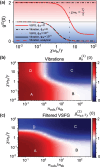Photon antibunching in single-molecule vibrational sum-frequency generation
- PMID: 39840390
- PMCID: PMC11744459
- DOI: 10.1515/nanoph-2024-0469
Photon antibunching in single-molecule vibrational sum-frequency generation
Abstract
Sum-frequency generation (SFG) enables the coherent upconversion of electromagnetic signals and plays a significant role in mid-infrared vibrational spectroscopy for molecular analysis. Recent research indicates that plasmonic nanocavities, which confine light to extremely small volumes, can facilitate the detection of vibrational SFG signals from individual molecules by leveraging surface-enhanced Raman scattering combined with mid-infrared laser excitation. In this article, we compute the degree of second order coherence (g (2)(0)) of the upconverted mid-infrared field under realistic parameters and accounting for the anharmonic potential that characterizes vibrational modes of individual molecules. On the one hand, we delineate the regime in which the device should operate in order to preserve the second-order coherence of the mid-infrared source, as required in quantum applications. On the other hand, we show that an anharmonic molecular potential can lead to antibunching of the upconverted photons under coherent, Poisson-distributed mid-infrared and visible drives. Our results therefore open a path toward bright and tunable source of indistinguishable single photons by leveraging "vibrational blockade" in a resonantly and parametrically driven molecule, without the need for strong light-matter coupling.
Keywords: cavity optomechanics; nanocavities; photon blockade; photonics; single photon source; vibrational spectroscopy.
© 2024 the author(s), published by De Gruyter, Berlin/Boston.
Conflict of interest statement
Conflict of interest: Authors state no conflicts of interest.
Figures









Similar articles
-
Continuous-wave frequency upconversion with a molecular optomechanical nanocavity.Science. 2021 Dec 3;374(6572):1264-1267. doi: 10.1126/science.abk3106. Epub 2021 Dec 2. Science. 2021. PMID: 34855500
-
In-operando control of sum-frequency generation in tip-enhanced nanocavities.Light Sci Appl. 2025 May 22;14(1):203. doi: 10.1038/s41377-025-01855-5. Light Sci Appl. 2025. PMID: 40404638 Free PMC article.
-
Detecting mid-infrared light by molecular frequency upconversion in dual-wavelength nanoantennas.Science. 2021 Dec 3;374(6572):1268-1271. doi: 10.1126/science.abk2593. Epub 2021 Dec 2. Science. 2021. PMID: 34855505
-
Nanocavities for Molecular Optomechanics: Their Fundamental Description and Applications.ACS Photonics. 2024 Nov 6;11(11):4486-4501. doi: 10.1021/acsphotonics.4c01548. eCollection 2024 Nov 20. ACS Photonics. 2024. PMID: 39584033 Free PMC article. Review.
-
Ultrafast nonlinear coherent vibrational sum-frequency spectroscopy methods to study thermal conductance of molecules at interfaces.Acc Chem Res. 2009 Sep 15;42(9):1343-51. doi: 10.1021/ar9000197. Acc Chem Res. 2009. PMID: 19388671 Review.
References
-
- Greentree A. D., Hollenberg L. C. L. High-performance diamond-based single-photon sources for quantum communication. Phys. Rev. A . 2009;80(5):052308. doi: 10.1103/physreva.80.052308. - DOI
LinkOut - more resources
Full Text Sources
